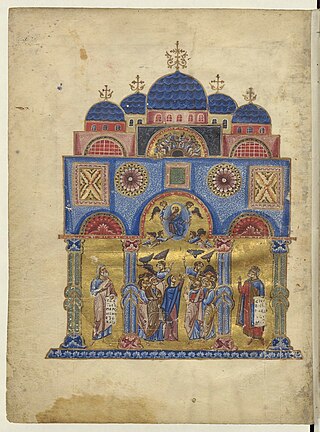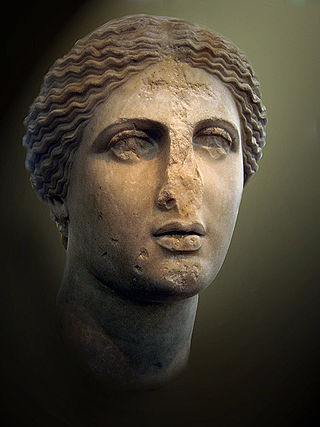

The Philadelphion was a public square located in Constantinople.


The Philadelphion was a public square located in Constantinople.
After passing the Forum of Theodosius, the Mese Odos (the main road of Constantinople) branched into two directions. One led to the quarter known today as Yedikule, via the Aksaray and Cerrahpaşa quarters. The other passed through the quarters of Şehzadebaşı and Fatih until reaching the quarter of Edirnekapı (formerly the Gate of Charisius). The space where the road forked was thought to be the physical centre, or mesomphalos, of the city.
According to the 8th-century Parastaseis syntomoi chronikai , the site of the later Philadelphion was originally known as the Proteichisma ("fore-wall"), and the site of a gate in the city wall built by Emperor Carus (r. 282–283). [1] Raymond Janin suggested that this Proteichisma was an outer defensive wall protecting the wall erected by Septimius Severus (r. 193–211) during his rebuilding of Byzantium, possibly indicating that the city had already expanded beyond the Severan wall. [2] The Parastaseis record the presence of statues of Constantine the Great (r. 306–337), his mother Helena, and his sons, seated on thrones, around a large four-sided porphyry column, topped by a gilded cross and marked with the sign of a sponge at the base, [3] as well as statues of Julian the Apostate and his wife, whom the Parastaseis erroneously records as Anastasia. Perhaps this was a statue of Constantine's sister Anastasia. [4] According to the Parastaseis, the column was erected by Constantine to commemorate his having a heavenly vision of the cross at the site; modern scholarship however considers the monument complex to be of later date, commemorating the finding of the True Cross by Helena. [5] The Patria of Constantinople furthermore records that statues of two sons of Constantine seated on thrones stood opposite from the column. These statues apparently survived until the early 15th century, when they were popularly known as the "True Judges". [6]
The Parastaseis records that the place received the name Philadelphion ("place of brotherly love") from a statue group showing the meeting of Constantine's three sons there after Constantine's death in 337 and their embrace as a sign of mutual devotion and support. The event never actually took place—Constantine's sons only met briefly in Pannonia after his death—but the statue probably existed, similar to another three-headed statue of Constantine and two of his sons, Constans and Constantius, which the Parastaseis record as lost at sea at the time of Theodosius II (r. 402–450), symbolizing concord in the imperial family. [7] In 1958, P. Verzone identified [8] the statue groups known as the "Tetrarchs", which was plundered during the Fourth Crusade in 1204, brought to Venice, and incorporated into the St Mark's Basilica, with the statues mentioned in the Parastaseis. This identification was reinforced by the discovery of a missing fragment from the statue group near the Bodrum Mosque, [9] but as the editors of the Parastaseis point out, "there are too many discrepancies between those groups and Parastaseis's descriptions here to permit any certainty". [10] Given the inaccuracy of the historical details in the Parastaseis, it is possible that even the identification with Constantine's sons is wrong, while it is unclear from the phrasing of the text whether this monument survived until the 8th century, or whether it had been destroyed long before. [11]

Constantinople became the capital of the Roman Empire during the reign of Constantine the Great in 330. Following the collapse of the Western Roman Empire in the late 5th century, Constantinople remained the capital of the Eastern Roman Empire, the Latin Empire (1204–1261), and the Ottoman Empire (1453–1922). Following the Turkish War of Independence, the Turkish capital then moved to Ankara. Officially renamed Istanbul in 1930, the city is today the largest city in Europe, straddling the Bosporus strait and lying in both Europe and Asia, and the financial centre of Turkey.

Leo I, also known as "the Thracian", was Roman emperor of the East from 457 to 474. He was a native of Dacia Aureliana near historic Thrace. He is sometimes surnamed with the epithet "the Great", probably to distinguish him from his young grandson and co-augustus Leo II.

The Hippodrome of Constantinople, was a circus that was the sporting and social centre of Constantinople, capital of the Byzantine Empire. Today it is a square in Istanbul, Turkey, known as Sultanahmet Square.

The Walls of Constantinople are a series of defensive stone walls that have surrounded and protected the city of Constantinople since its founding as the new capital of the Roman Empire by Constantine the Great. With numerous additions and modifications during their history, they were the last great fortification system of antiquity, and one of the most complex and elaborate systems ever built.

The Church of the Holy Apostles, also known as the Imperial Polyandrion, was a Byzantine Eastern Orthodox church in Constantinople, capital of the Eastern Roman Empire. The first structure dated to the 4th century, though future emperors would add to and improve upon it. It was second in size and importance only to the Hagia Sophia among the great churches of the capital.
George Kodinos, also Pseudo-Kodinos or Codinus, is the conventional name of an anonymous late 15th-century author of late Byzantine literature.

The Horses of Saint Mark, also known as the Triumphal Quadriga or Horses of the Hippodrome of Constantinople, is a set of bronze statues of four horses, originally part of a monument depicting a quadriga. The horses were placed on the facade, on the loggia above the porch, of St Mark's Basilica in Venice, northern Italy, after the sack and looting of Constantinople in 1204. They remained there until looted by Napoleon in 1797 but were returned in 1815. The sculptures have been removed from the facade and placed in the interior of St Mark's for conservation purposes, with replicas in their position on the loggia.

The Forum of Constantine was built at the foundation of Constantinople immediately outside the old city walls of Byzantium. It marked the centre of the new city, and was a central point along the Mese, the main ceremonial road through the city. It was circular and had two monumental gates to the east and west. The Column of Constantine, which still stands upright and is known today in Turkish as Çemberlitaş, was erected in the centre of the square.

Judith Herrin is an English archaeologist, byzantinist, and historian of Late Antiquity. She was a professor of Late Antique and Byzantine sudies and the Constantine Leventis Senior Research Fellow at King's College London.

The Column of Justinian was a Roman triumphal column erected in Constantinople by the Byzantine emperor Justinian I in honour of his victories in 543. It stood in the western side of the great square of the Augustaeum, between the Hagia Sophia and the Great Palace, and survived until 1509, its demolition by the Great earthquake of Constantinople which affected other historical places as well.

The AqueductofValens was a Roman aqueduct system built in the late 4th century AD, to supply Constantinople – the capital of the Eastern Roman Empire. Construction of the aqueduct began during the reign of the Roman emperor Constantius II and was completed in 373 by the Emperor Valens. The aqueduct remained in use for many centuries. It was extended and maintained by the Byzantines and the Ottomans.

The Augustaion or, in Latin, Augustaeum, was an important ceremonial square in ancient and medieval Constantinople, roughly corresponding to the modern Aya Sofya Meydanı. Originating as a public market, in the 6th century it was transformed into a closed courtyard surrounded by porticoes, and provided the linking space between some of the most important edifices in the Byzantine capital. The square survived until the late Byzantine period, albeit in ruins, and traces were still visible in the early 16th century.
The Palace of Antiochos was an early 5th-century palace in the Byzantine capital, Constantinople. It has been identified with a palatial structure excavated in the 1940s and 1950s close to the Hippodrome of Constantinople, some of whose remains are still visible today. In the 7th century, a part of the palace was converted into the church–more properly a martyrion, a martyr's shrine–of St Euphemia in the Hippodrome, which survived until the Palaiologan period.

The Chalke Gate, was the main ceremonial entrance (vestibule) to the Great Palace of Constantinople in the Byzantine period. The name, which means "the Bronze Gate", was given to it either because of the bronze portals or from the gilded bronze tiles used in its roof. The interior was lavishly decorated with marble and mosaics, and the exterior façade featured a number of statues. Most prominent was an icon of Christ which became a major iconodule symbol during the Byzantine Iconoclasm, and a chapel dedicated to the Christ Chalkites was erected in the 10th century next to the gate. The gate itself seems to have been demolished in the 13th century, but the chapel survived until the early 19th century.
The Patria of Constantinople, also regularly referred to by the Latin name Scriptores originum Constantinopolitarum, are a Byzantine collection of historical works on the history and monuments of the Byzantine imperial capital of Constantinople.

Persecution of pagans in the late Roman Empire began during the reign of Constantine the Great in the military colony of Aelia Capitolina (Jerusalem), when he destroyed a pagan temple for the purpose of constructing a Christian church. Rome had periodically confiscated church properties, and Constantine was vigorous in reclaiming them whenever these issues were brought to his attention. Christian historians alleged that Hadrian had constructed a temple to Venus on the site of the crucifixion of Jesus on Golgotha hill in order to suppress Christian veneration there. Constantine used that to justify the temple's destruction, saying he was simply reclaiming the property. Using the vocabulary of reclamation, Constantine acquired several more sites of Christian significance in the Holy Land.

The Amastrianum, also called Forum Amastrianum by modern authors, was a public square in the city of Constantinople. Used also as place for public mutilations and executions, it disappeared completely after the end of the Byzantine Empire.

The Prosphorion Harbour was a harbour in the city of Constantinople, active from the time when the city was still the Greek colony of Byzantium, until the eve of the first millennium. Gradually enlarged, it was the first port to be built in the area of the future Constantinople.
Exakionion or Exokionion (Ἑξωκιόνιον) was an area in Byzantine Constantinople. Its exact location and extent vary considerably in the sources.

The Column of Leo was a 5th-century AD Roman honorific column in Constantinople. Built for Leo I, Augustus of the East from 7 February 457 to 18 January 474, the column stood in the Forum of Leo, known also as the Pittakia. It was a marble column, without flutes, composed of drums with a Corinthian capital, surmounted by a statue of the emperor.
{{cite book}}: CS1 maint: location missing publisher (link)